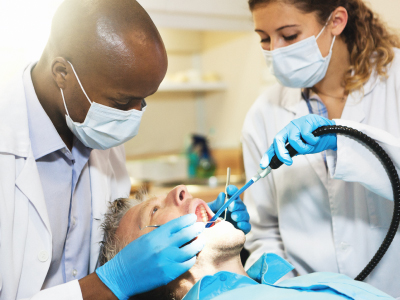Partial Dentures
PARTIAL DENTURES IN SAN ANTONIO
PARTIAL DENTURES OVERVIEW
Partial dentures, or bridges, are attached to the teeth to fill in gaps where other teeth are missing. Bridges may be removable or may sit in a fixed position using a crown. Bridges help maintain the appearance of a healthy smile while also keeping the remaining teeth in their proper alignment instead of shifting over time.
Benefits of Partial Dentures
Dentures have helped people live better and look better for generations. Numerous improvements have been made to these valuable medical prosthetics; today’s dentures are more comfortable and more natural-looking than they have ever been. While many sets of dentures are intended to replace the loss of many teeth are well-known, many people remain unaware of the benefits of partial dentures. Partial dentures and similar forms of bridgework are intended to replace several teeth that have been lost or had to be removed due to decay or injury. A partial denture fulfills the same purposes as a full denture, namely making it possible to eat, speak, and smile more naturally.
Warning Signs
Soreness at the corners of the mouth: If your dentures alter the way your mouth closes, saliva may gather in the corners of the lips. This moisture can, over time, lead to conditions or infections like cheilosis or stomatitis. Your dentist can best determine the cause of soreness and how to alleviate it.
Irritation of the gums: Irritation can be caused by food particles rubbing against the gums after getting trapped under the dentures. Friction can lead to sores or bleeding, and if it’s persistent, you should see your dentist to rule out other possibilities.
Slippage: If dentures fit appropriately, there should not be an issue with suction. As the mouth changes, the seal between the gums and the device may weaken. If your dentures are not adhering the way they once did, contact your dentist.
When Dentures Are Prescribed
- When there is difficulty eating due to missing teeth
- When there is difficulty with pronunciation
- To restore the appearance of the patient’s smile and overall facial structure
Types of Dentures
Dentures will fall into one of two groups: partial or complete.
PARTIAL
Partial dentures, or bridges, are attached to the teeth to fill in gaps where other teeth are missing. Bridges may be removable or may sit in a fixed position using a crown. Bridges help maintain the appearance of a healthy smile while also keeping the remaining teeth in their proper alignment instead of shifting over time.
COMPLETE
Complete dentures replace an entire arch. Following a few months of total tooth loss, conventional dentures are placed in the patient’s mouth. This is done to allow the gums a chance to heal. Immediate dentures can be used immediately following extraction, but immediate dentures do not allow for the tissue and bone to settle, which will require adjustment over time. Immediate dentures are generally exchanged for conventional dentures as time goes on.
Patient Experience
A DENTIST OR PROSTHODONTIST WILL TREAT YOU FOR DENTURES AND INSTRUCT YOU IN THEIR CARE.
- The dentist will take an impression of the dimensions of your jaw and how the arches sit in relation to one another.
- The dentist will then create a model for you to try.
- As you wear this model, you can detect any needed changes of the model for further adjustments.
- Once the model fits appropriately, the prosthesis will be processed
- You will then be able to wear your dentures.
- During the first few weeks, you may be asked to wear your dentures all the time to get used to them and to detect any possible flaws in the design.
- You should steer clear of hard or sticky foods and may need to stick with soft food in small portions until you get used to the prosthesis.
- Talking may be difficult initially, but you should be able to communicate without issue after some practice.
- Because the brain does not immediately recognize this new prosthesis, you may salivate more than usual. Gagging may also occur.
- Dentures may come loose when you cough or laugh. This is normal and easily corrected.
- Follow your dentist’s instructions for how to clean and care for your dentures. Only use adhesive if your dentist approves.
- Your jaw will change over time. Plan to change your dentures every five to seven years for optimal results.


 We will be disinfecting all counters, door handle and hard surfaces in the waiting room at regular intervals. Also, we will ask all patients to use disinfection wipes that the front desk team members will provide before signing in and checking out. We as a rule disinfect hard surfaces and equipment in our operatories based on infection control guide lines.
We will be disinfecting all counters, door handle and hard surfaces in the waiting room at regular intervals. Also, we will ask all patients to use disinfection wipes that the front desk team members will provide before signing in and checking out. We as a rule disinfect hard surfaces and equipment in our operatories based on infection control guide lines. Please keep your regular dental appointment if you are not ill or have not come into contact with ill patients.
Please keep your regular dental appointment if you are not ill or have not come into contact with ill patients.